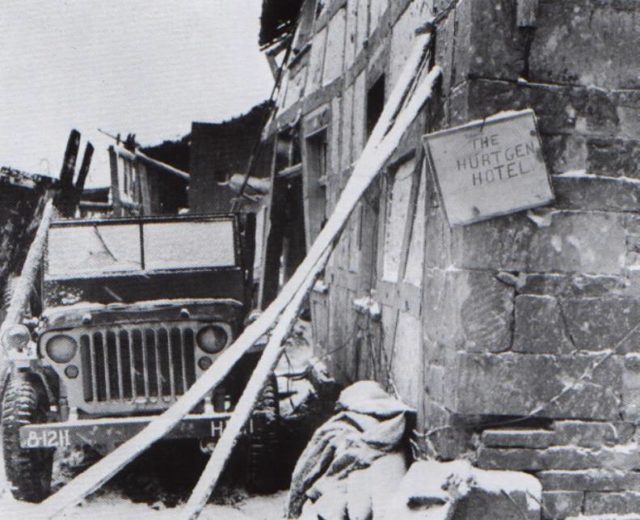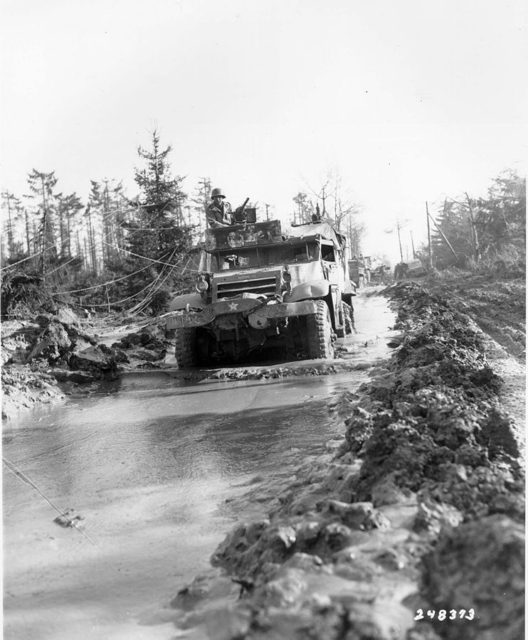October 7, 1994, saw a strange sight over the Hürtgen War Cemetery in Hürtgen, Germany. The cemetery is the final home of 3001 bodies – mostly German and mostly from WWII. It is therefore quite common to see Germans gather there to honor their dead.
But on that day, there was another group paying their respects to the fallen. Led by Lieutenant Colonel John Ruggles, former Regimental Executive Officer of the 22nd Infantry, the men were setting up a monument to a German officer.
What makes the whole thing strange was that the men were American veterans of WWII. Not only that but they had actually fought the German officer they were there to honor.
To understand this, we have to go back to 1944. The D-Day landings at Normandy saw the Allied forces gaining ground and fighting their way through Normandy one hedgerow at a time. Then came the breakout and in August of 1944 the Germans were pushed back towards Germany, often retreating faster than the Allies were able to advance.
Buoyed by their success, the Allies continued their rapid advance toward Germany. In so doing, they overextended their supply lines which slowed their progress and gave the Germans some breathing room by which to rebuild their strength.
By mid-September, the US First Army wanted to cross the Rhine River into the German heartland, but they were blocked outside the city of Aachen. By October, the US 1st Infantry Division arrived to support the XIX Corps and the VII Corps as it surrounded the city which still refused to surrender.
On November 4th, the Americans retreated to Kommerscheidt where they pushed the enemy back. They again attacked Schmidt and fighting continued until November 10th when they were forced to retreat.
Lt. Friedrich Lengfeld was with the 275th and became commander of the 2nd Company when his Company Commander died in October. November saw them in Vossenack between Schmidt and Hürtgen, fighting desperately to save the town with the 116th Panzer Division that would eventually dislodge the Americans and force them to retreat.
There was also concern about the Ruhr Dam. The Americans feared that the Germans might destroy it, creating a deluge that would mire down the Allied forces further downstream. To get to that dam as quickly as possible, they had to go into the Hürtgen forest which lay between the city and the Ruhr. A dense forest with steep hills and deep ravines.

Opposing them were the German 275th and 353rd Infantry Divisions under Lieutenant General Hans Schmidt. These had dug themselves in by setting up minefields, barbed wire, and booby-traps. They also used bunkers which serviced the Siegfried Line – a series of defenses along Germany’s western border which was built between 1936-1939 and was then abandoned for four years. Nature took over and gave the German bunkers near-perfect camouflage.
They knew the terrain well, some came from the nearby villages, and being there first, were able to prepare their defenses. Although the Allies were superior in the air, the dense vegetation of the forest virtually nullified their advantage since pilots couldn’t identify enemy targets. So while the Germans were outnumbered five to one, the odds were still in their favor.
The structure was beside a minefield the Germans called “Wilde Sau” (wild sow) and despite its decrepit condition, it provided some shelter from the elements. The following day, Lengfeld lost two men from sniper fire, so they prepared for another attack.

Later that evening, the US 12th Infantry captured the lodge, causing Lengfeld to lose more men. Rallying around him, they launched a counterattack and managed to drive the Americans out the following morning. As the Americans retreated, one of them ran directly into the Wilde Sau with disastrous consequences.
On September 19th, the US 60th Infantry Regiment made their first foray into the forest but were beaten back. They had suffered some 4,500 casualties by October 16th when the US 28th Infantry Division joined them. The 28th launched a major assault on the German positions on November 2nd and captured the town of Schmidt the next day before they were expelled by a strong German counterattack.

By November 10, Lengfeld’s company was exhausted. The group had been decimated, and those who survived hadn’t bathed in days. Everyone was suffering from a serious bout of lice, hunger, malnutrition, and severe cold, as well as damp because of the snow and rain.
They had been fighting over a forester’s lodge in the woods to the south of where the Hürtgen War Cemetery now stands. At the time, the lodge had been used as a shelter by both sides depending on who held it.

Though severely injured, the American survived and began calling out for help. Beside the minefield was a safe path guarded by a German machine gun. Lengfeld ordered Hubert Gees (a rifleman and his communications runner) to go to the gunner and tell him not to fire at any Americans who came to rescue the man.
Hours passed and no one came for him, either believing he was dead or because the Americans had retreated in disarray. Unable to take the man’s cries any longer, Lengfeld decided to mount a rescue himself.

The lodge was located beside a road protected with antitank mines the company had placed and knew the locations of. At around 10:30 AM, Lengfeld led a team of medics beside the road till he got opposite the American soldier. He then went into the minefield, but as he got off the safety of the path, he stepped on a hidden anti-personnel mine which blasted him away.
They quickly carried Lengfeld back to the lodge, but it was too late. There were two deep holes in his back, and he was suffering from serious internal injuries. They managed to get him to the First Aid Station in Froitzheim where he died later that evening.

Raimond Spekking – CC-by-SA-3.0
The identity of the American soldier remains unknown.
The Battle of Hürtgen Forest was one of the longest battles fought in WWII, lasting from September 1944 until February 1945 at a cost of some 33,000 American lives and about 28,000 German ones.
Despite this, Ruggles felt compelled to honor Lengfeld’s heroism during the battle’s 50th anniversary. And that’s why veterans of the 22nd US Infantry Society set up a monument in his honor at the cemetery.
In part, it reads: No man hath greater love than he who layeth down his life for his enemy
